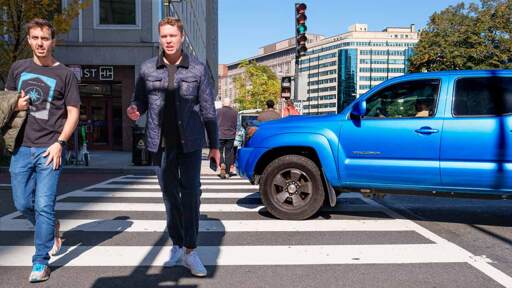IIHS researchers analyzed pedestrian crashes to develop injury risk curves showing how speed affects crash outcomes. They found that the effect of crash speed on injury risk was magnified for vehicles with taller front ends. Compared with risk curves developed using crash data from Europe, where tall passenger vehicles are less common, risk curves for the U.S. show pedestrians here begin to suffer more serious injuries at lower speeds.



At the risk of feeding the troll, here is the math you are suggesting we do, which disproves all of your arguments. It pains me how confidently you speak of a topic you are clearly so uneducated about: your physics mentors should be disappointed in you.
Conservation of linear momentum:
m1v1i + m2v2i = m1v1f + m2v2f
Let the vehicle be m1 and the human m2. Let the human’s initial velocity be zero. Let us further assume an inelastic collision: the human and vehicle end up at the same final speed v1f=v2f=vf.
Thus:
m1v1i = (m1+m2)vf
What we are concerned of is the ratio of initial vehicle speed, v1i, to post-collision speed vf. Your argument is that a lighter vehicle will have a larger drop-off in speed, recovering energy and reducing the severity of the collision. If you were right, the ratio v1i/vf should be less than 1.0, and be significantly different for a heavy and light vehicle. We will prove this wrong shortly.
Rearranging:
v1i/vf = m1/(m1+m2)
Already it is abundantly clear that when m1 >> m2, v1i/vf will be 100%. I will leave you no room for counterargument here by working two examples. Take the most popular pickup truck, the Ford F150, at 2125 kg. Take one of the smallest compact cars, a Honda Fit, at 1130 kg. Take the average adult human, at 65 kg.
For the F150: v1i/vf = 2125/(2125+65) = 97%
For the Honda fit: v1i/vf = 1130/(1130+65) = 95%
At 35 mph, that’s a difference in speed delta of 0.7 mph, which is absolutely insufficient to explain the delta in injury severity presented in this article.
This proves what everyone knew all along: vehicle mass is insignificant in crash severity with a pedestrian because the masses of the two objects are so different. When the masses are similar (e.g. a small car colliding with a big car) yes, mass is important. But that’s not what is being discussed and is not your argument.
I hope you go back to school and learn the basics before confidently acting superior. Take your downvotes and learn from this to do better.
This is where you went wrong.
But, you’re not asking questions. So, I’ll not invest into answers.